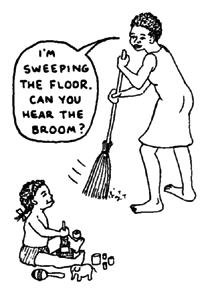Auditory Stimulation:
Hold your baby and talk to him *face to face*. Make eye contact even if your child canít. This provides vision stimulation and places the child in a position to reach out and touch you. It encourages imitation and adds to the bond between you.
Choose one to three favorite songs, poems or stories and do them every day. This will help develop your childís memory as well as interactive skills and help to stimulate speech.
Comment on babyís movements. Respond to her sounds with words If your child is hearing-impaired, touch her to respond to movements and sounds..
There are products on the market available from New-Age shops which combine aromatherapy burners with different sounds such as birds, nature, the ocean etc etc. They can be set to a timer and set to go off after an hr or so. Boots in Rep of Ireland sell a very good one.
There are some wonderful toys on the market some which work at touch of a button and speak a word with sound effects. The RNIB produce a great toy list of mainstream toys made by Tomy, Vetek and others which are really great for special needs children. Early Learning Centre have many multi-sensory toys.
Avoid clutter; itís confusing. This is true of clutter you can see and clutter you can hear. Donít provide more than two or three toys at a time. Donít have the TV or the radio on at the same time. If your child is playing with a sound toy or you are singing to him, turn the TV or radio off.
Tell your baby what is about to happen before you begin or end an activity.
Stimulate all the senses: sight, touch, taste, smell, hearing. This is best accomplished by including your child in everyday activities. Bring her into the kitchen, laundry room, bathroom, etc. Talk to her about what you are doing. Let her touch things before you use them: her diaper before sheís changed; her washcloth before sheís washed; her spoon before she eats.

Music
Relaxation sounds and CDs which are melodic to lull him to sleep. As well as classical music, pop music and nursery rhymes and songs to stimulate him.
This can make a fun game if you use a toy such as drum or rattle (or a bell anklet on his leg) and you waggle his hand or leg in time to the music, this is guaranteed to make him smile. Wrist rattles here are also good fun if you attach them to his ankles and wrists!
Tactile Stimulation
If you're inventive you can create a multi-sensory world for your child just by using your imagination.
Hand and/or feet painting - using leaves, marbles or other objects.
Involve an older (sighted) sibling by giving them a project. For example every day after school they must bring home at least one object for him to explore - i.e.: different flowers, leaves, large rocks (under supervision of course - ensuring the parts are not too small or dangerous)
Pet shops are brilliant places to buy noisy toys!!! A big hit is a ball with a bell in it.
Use a plastic 2 litre bottle - filled with rice/pasta etc for a lovely noisy sound